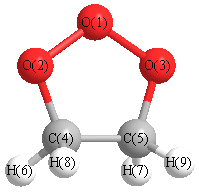Vibrational Frequencies calculated at QCISD/6-311G**
| Mode Number |
Symmetry |
Frequency
(cm-1) |
Scaled Frequency
(cm-1) |
IR Intensities
(km mol-1) |
Raman Act
(Å4/u) |
Dep P |
Dep U |
|---|
| 1 |
A' |
3172 |
3026 |
31.34 |
|
|
|
| 2 |
A' |
3094 |
2952 |
46.33 |
|
|
|
| 3 |
A' |
1544 |
1473 |
0.15 |
|
|
|
| 4 |
A' |
1379 |
1316 |
0.41 |
|
|
|
| 5 |
A' |
1272 |
1213 |
2.39 |
|
|
|
| 6 |
A' |
1049 |
1001 |
34.52 |
|
|
|
| 7 |
A' |
965 |
920 |
10.76 |
|
|
|
| 8 |
A' |
923 |
881 |
3.81 |
|
|
|
| 9 |
A' |
873 |
833 |
1.30 |
|
|
|
| 10 |
A' |
725 |
692 |
2.17 |
|
|
|
| 11 |
A' |
426 |
407 |
4.19 |
|
|
|
| 12 |
A" |
3155 |
3010 |
0.61 |
|
|
|
| 13 |
A" |
3083 |
2941 |
25.75 |
|
|
|
| 14 |
A" |
1528 |
1458 |
0.19 |
|
|
|
| 15 |
A" |
1376 |
1313 |
1.47 |
|
|
|
| 16 |
A" |
1246 |
1188 |
0.04 |
|
|
|
| 17 |
A" |
1177 |
1123 |
0.01 |
|
|
|
| 18 |
A" |
1062 |
1013 |
2.69 |
|
|
|
| 19 |
A" |
786 |
750 |
36.35 |
|
|
|
| 20 |
A" |
743 |
709 |
0.41 |
|
|
|
| 21 |
A" |
132 |
126 |
3.97 |
|
|
|
Unscaled Zero Point Vibrational Energy (zpe) 14854.6 cm
-1
Scaled (by 0.9541) Zero Point Vibrational Energy (zpe) 14172.8 cm
-1
See section
III.C.1 List or set vibrational scaling factors
to change the scale factors used here.
See section
III.C.2
Calculate a vibrational scaling factor for a given set of molecules
to determine the least squares best scaling factor.
